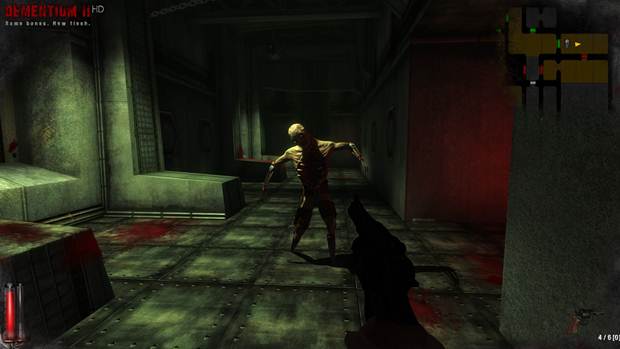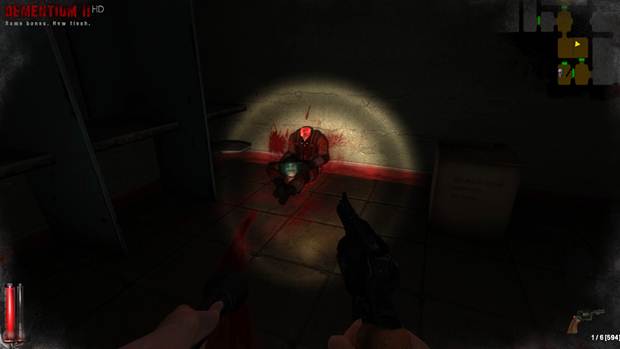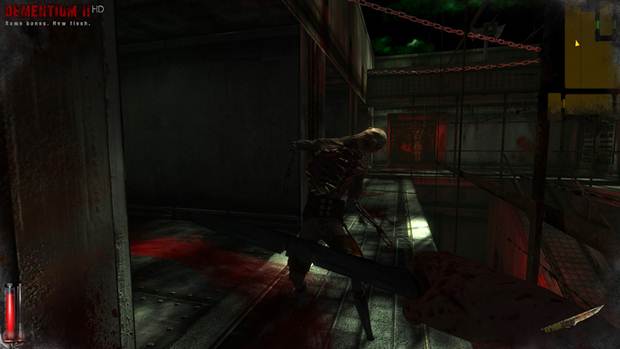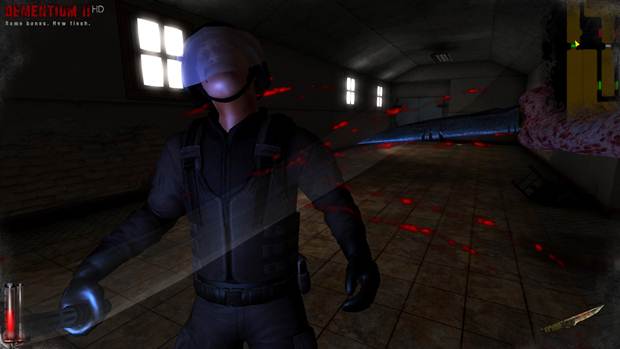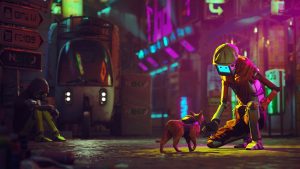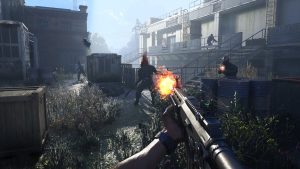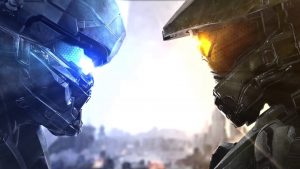
Dementium II HD is a port of the Nintendo DS sequel to the original Dementium. It casts you in the shoes William Redmoor, a man who has spent the past 5 weeks unconscious after undergoing brain surgery. Upon waking up in Clandestine Bright Dawn Treatment Center, it seems the demonic nightmares that taunted and pursued William from the previous game are far from over.
Drifting in and out of a dream like state where the world around you becomes a demonic nightmare unsuitable to live in, it’s not long before you find yourself armed with a knife and a revolver, forced to kill every demon and security officer standing in your way.
"The game has a unique transition of blending gameplay into cut scenes, and although some may find this of an irritation as it is done so randomly, I sense this was implemented as a way of delivering immersion onto the player."
Dementium 2 carries a strong storyline that fans of the series or those who experienced the game on the handheld platform will be happy to witness once again. While it falls off at times and feels like there are certain aspects missing, those new to the Dementium series will have no need other than curiosity to go back and visit the first game.
The game has a unique transition of blending gameplay into cut scenes, and although some may find this of an irritation as it is done so randomly, I sense this was implemented as a way of delivering immersion onto the player, into the mind of a character who’s essentially losing his mind. The only hiccups with this implementation is the change in resolution, but nevertheless I found it to be a good method for delivering those jumps and scares that games like this rely on.
Dementium 2 isn’t just horror, its involvement of action and fighting back within this horror is recognized, and so the weapons available to the player means you are not constantly running away. As most encounters are usually triggered by surprise in the first place, you have no choice but to fight back, as the game provides no alternatives such as hiding, other than going into another room and hoping for an alternate route. Since the game overlays a map of the hospital in the top right corner of the screen, you are always aware of the routes available to you highlighted by red and green doors.
"Enemy boss battles are present here to but don't provide any unique way of tackling them. They play in the same manner to that of the other enemy encounters in the game, and it would have been nice to see this taken a little bit further."
There’s also a few puzzles in the game relating to the opening of previously unavailable areas. These puzzles aren’t complicated in any sort nor do they overstay their welcome by holding their own emphasis or getting in your way. They’re puzzles with meaning and I didn’t have any problem with them whatsoever. Enemy boss battles are present here to but don’t provide any unique way of tackling them. They play in the same manner to that of the other enemy encounters in the game, and it would have been nice to see this taken a little bit further. Had the enemy battles been taken to the same impressive heights of their art direction, It would have been much more enjoyable.
As you travel through this demented hospital, you come across documents and notes detailing the information of other patients, as well as background information on the center itself. While this is a common practice in games of this genre and those comparable, such as Outlast and Amnesia, it never seems to get old, and in games like this where patient files actually make sense, it adds to the immersion and gives the game such strength, without appearing as a rip-off from another game.
Immersion is the key when it comes to games of the first-person nature, particularly in games that rely on fear, elements of horror, and the own insecurities as well as expectations that the player has. It’s in the smallest details such as patient files and hidden background information on the environment and its characters, where that extra touch of immersion is realized. As you find these documents and take the time to read through them, it’s in your own curiosity, doubts, and mystery that you find yourself entangled within the game.
"It's hard to believe that the game was originally ported from the Nintendo DS, and the control scheme in particular will still have some people doubting it. The controls are optimized so well for the PC, although be them simple in nature. "
As I experienced the game on a dark and rainy day, with headphones on for that extra sense of immersion, what the game threw back at me was something truly exciting, fearful, and largely enjoyable. With a promise of more games next year making a return to horror and survival they would do well to learn from games like this. The transition into the third-person shooter genre, has caused a few people to slip, and in doing so they have forgotten what fear and horror is all about. It’s the back to basics ethics without the over-the-top extras of experimentation of other genres that Dementium II HD holds so well, even if it does include traits taken from first-person shooters.
It’s hard to believe that the game was originally ported from the Nintendo DS, and the control scheme in particular will still have some people doubting it. The controls are optimized so well for the PC, although be them simple in nature. With that being said it’s easy to see how the in-game inventory would have adapted itself to the Nintendo DS’ second screen, as it’s moved by default to Tab key, which is something of a standard for the majority of PC games.
Everything else is placed as it should be with your standard movement assigned to the WASD keys, and your main means of attack on the left mouse button. It’s clear the effort and attention was given when porting over the game. Where most games have their attention placed primarily on the graphics when it comes to ports, the controls transitioned appropriately, and manage to exist peacefully in contrast to its gameplay.
"The environmental assets of Dementium II HD such as the blood soaked walls, screaming patients, and face-chested demons, are molded so tightly together and create such an intense and uncertain environment, that it left me wondering how much greater it could have been had it been originally made for the PC."
Using the weapons available to you is one thing that some may have an issue with. Attacking with the knife works in a basic fashion of hacking and slashing back and fourth, and guns don’t feel totally solid when firing at enemies. The aiming seems to suffer from an issue of slight wondering but isn’t in anyway a game-breaking problem. It’s hard to discourage minor faults like this considering it came and worked well on the Nintendo DS. You can see the potential had it been originally developed on the PC, but it doesn’t hurt its gameplay in anyway that can give arise to any frustration whereby you pack it in and stop playing.
That’s not to say there was no attention placed on the visual aspects of the game, as it looks “just right”, giving from where it’s coming from. I encountered no glitches, bugs, or collision detection issues whatsoever, and although there’s no detailed graphical options other than a slide bar and a V-Sync toggle, the game looks “just right”. You won’t find any high-res textures upgrades, or blooming DX11 lighting features, and although I would have gladly appreciated them I didn’t find this to be something that put me off its gameplay.
The environmental assets of Dementium II HD such as the blood soaked walls, screaming patients, and face-chested demons, are molded so tightly together and create such an intense and uncertain environment, that it left me wondering how much greater it could have been had it been originally made for the PC. I imagine some would argue the need for bigger environments and more going on within the scenery, but considering the game came from a handheld platform which is superbly limiting in what can be achieved to that of a PC or even a home console, this cannot be faulted. This graphical transition has gone over well to the PC, and those unfamiliar with the game’s existence over on the Nintendo DS wouldn’t have known otherwise.
"While the environmental sounds could have been exploited more and had better use taken to them, the screams, moans, the repetitive mumbles of patients belted to the beds, and the stumbling of enemies as they make their way towards you, is overwhelming."
When experiencing something that relies on fright, adrenaline, and the audience’s engagement and focus, no matter what the medium is the use of sound is crucial in making your heart skip a beat. Whether it be games, films, or even books, which in itself is derived from the audience’s own mind rather than the page. The attention on the audio can be one of the most important factors if not the first. It’s usually the first thing to reach your senses and what keeps you on edge for however long the experience may be.
A game that exists in the realm of horror is nothing more than a barrage of annoyance, if it doesn’t have the right sound solution to drive its purpose, as well as the player’s motivation to play on. Dementium II HD captures this essence in its purest of form and it’s clear the team knows what they’re doing. While the environmental sounds could have been exploited more and had better use taken to them, the screams, moans, the repetitive mumbles of patients belted to the beds, and the stumbling of enemies as they make their way towards you, is overwhelming. It succeeds in giving the player that sense of pressure, and the motivation to say yourself, “If I don’t fightback I am going to die”.
The real leader in this acoustic amusement of death is the game’s music. As a personal preference to games involving horror I often keep the music levels at a low, just loud enough to hear but not pay attention to. Then taking advantage of the slider bars relating to in-game sound effects, I place these at a maximum in order to truly pull myself into the game’s world and witness all of its terrifying attributes. However, playing through Dementium II HD I found myself doing quite the opposite.
As I mentioned before the environmental sound could have been better, but on the music side of things the team over at Renegade Kid have produced something of greatness. Despite its success of doing so well on the Nintendo DS, the attention placed on sound isn’t something that many gamers will take notice of on a handheld platform. Dementium 2 is a different story and it’s this feature that blends itself well to the PC platform, that managed to grace my headphones.
This game was reviewed on the PC.
The effort taken to suit the PC platform as well as the amazing use of sound is what stands out the most.
More variety in dealing with enemy bosses is welcomed and the control mechanics need an adjustment.









